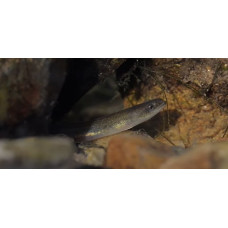Latin name
Anguilla anguilla
Other names
Anguilla anguilla
Identification
It has a long body with a brownish-greenish back, with yellowing on the sides and belly. The skin is very smooth and the scales are fine. The body is serpentine, cylindrical at the front and slightly compressed at the back. The rather large head is slightly flattened at the top. The eyes are small (1/8 to 1/12 of the length of the head) and are located above the corners of the mouth. The jaws and scutellum have several rows of small, sharp teeth. The dorsal and anal fins are fused to the caudal fin. The dorsal fin begins well behind the pectoral fins but in front of the anal opening. The pectoral fins are well developed, the ventral fins are absent. The lateral line is well defined. The pectoral fins have 15-21 rays; the number of vertebrae is 111-119, usually 114-116. Colouration varies greatly. In juveniles, the back is dark green, olive or grey-brown without markings, the belly is yellow or yellowish-white, becoming silvery-white in adults.
Distribution
Inhabits waters of the Baltic Sea basin, in much smaller numbers - rivers and lakes of the basins of the Azov, Black, White, Barents and Caspian Seas. It can be found in many waters in the European part of Russia.
Habitat
Typical passage fish. Life cycle with metamorphosis. Able to cross large areas of land on wet grass from rain or dew, moving from one body of water to another, ending up in closed, unlined lakes. It prefers calm waters, but can also be found in fast currents. It stays in the lower layers at various depths and on any bottom in shelters which can be: burrows, rocks, driftwood, dense thickets of grass.
Size
The maximum length is 122 cm and the mass is up to 6.6 kg.
Life history and Behavior
Spends most of its life in freshwater and enters the sea to spawn. Life cycle with metamorphosis.
Food and feeding habits
It feeds on insect larvae, molluscs, frogs and small fish.
Reproduction
The life cycle of the European eel is unique in many ways. The eel spawns 8000 km from its feeding grounds at a depth of 400 m in the Sargasso Sea, where the temperature reaches +16 - +17 °C, after which it dies. The eggs are about 1 mm in size, and a female can produce half a million of them. Development begins in the larval stage, when the eel's body resembles a willow leaf. It is flattened, translucent, with only the black eyes standing out. The larva is so different from the adult eel that it was once considered a separate species of fish and still has its own name - Leptocephalus. The larva floats to the surface and, carried by the Gulf Stream, travels for three years with the warm mass of water to the shores of Europe. As it approaches, the larva, which is about 8 cm long and 1 cm high, temporarily stops feeding and shrinks to 5-6 cm, transforming itself into a glass eel. It is still transparent, but the body is already oval from the sides, in the shape of a snake. At this stage, the eel approaches the mouths of rivers. As it moves upstream, it acquires an opaque colouration and becomes an adult river eel. After living in rivers for 9-12 years, the eel migrates ("rolls") back to the sea to spawn. It seems to be guided by currents and, according to some theories, by the earth's magnetic field. The colouring of the back becomes blacker and the belly and sides become silvery. Only then are the differences between males and females clearly visible.
Interesting facts
European eels dislike light. This characteristic is utilized in fishing. In Denmark and Sweden, fishing is conducted as follows. A narrow, dark corridor is left in an illuminated area. A net trap is installed at the end of the corridor. The fish swim through the dark passage to avoid the light and get caught in the trap.
| Classification | |
| Phylum | Chordata |
| Class | Actinopterygii |
| Squad | Anguilliformes |
| Family | Anguillidae |
| Genus | Anguilla |
| Species | A. anguilla |
| Features | |
| Conservation status | Critically Endangered |
| Habitat | Pelagic |
| Life span, years | No information |
| Maximum body weight, kg | 6,6 |
| Maximum length, cm | 122 |
| Sailing speed, m/s | No information |
| Threat to people | Edible |
| Way of eating | Predator |
European eel
Tags: european eel



